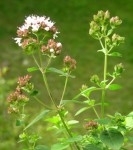Stay Informed
Popular Articles
- Hiatal Hernia: Hidden Cause of Chronic Illness
- Small Intestinal Bacterial Overgrowth (SIBO)
- Applied Lymphology: Unlocking the Secret to Pain Relief
- An Introduction to Constitutional Iridology
- The Low Down on Liver Detoxification
- An Energetic and Emotional Approach to Cancer
- Fat Facts
- Marrow in the Bones
- Blood Type and Nutrition
- Cardiac Herbs: Beyond Hawthorn
Quick Search
The School of Modern Herbal Medicine




Oregano
- 6/19/2013
- Categorized in: Herbs & Herbalism

Latin Name: Origanum vulgare
Parts Used: Aerial parts, essential oil
Description & Habitat: Oregano grows wild throughout the world, but is native to the Mediterranean area. It is an upright perennial herb growing to about 32” (80 cm) tall, with square red stems, elliptical leaves, and clusters of bright pinkish-purple flowers.
Constituents: Oregano contains a volatile oil rich in pungent-tasting carvacrol. The oil also contains thymol, beta bisabolene, caryophyllene, linalool and borneol, as well as a bitter principle consisting of flavonone neohesperidoside. It also contains flavonoids, tannins, phenolic acids, resins, and sterols. Wild oregano (Oreganum vulgare) has the most potent medicinal qualities.
Historical Uses
Oregano has been used for thousands of years as a spice and as a medicine. Hippocrates, the Father of Medicine, used Oregano as an antiseptic and as a cure for stomach and respiratory ailments. The ancient Greeks used Oregano for treating bacterial skin infections, wounds, and to protect food from bacteria. Oregano oil aided digestion and was used to treat food poisoning. The Romans made Oregano poultices for scorpion and spider bites. Oregano was also considered a protective herb that could ward of trouble and meddling individuals. The 18th century herbalist, K’Eogh described oregano as having “a hot dry nature… good against pains of the stomach and heart and also useful for coughs, pleurisy and obstructions of the lungs and womb, and it also comforts the head and nerves.”
 Modern Uses
Modern Uses
Today, wild oregano and its essential oil are used to kill bacteria, fungi, yeast, parasites and viruses. It is also used to treat diarrhea, intestinal gas, sore throats, sinusitis, coughs, nervous tension, breathing difficulties, dandruff, diaper rash, rheumatism, earache, toothache, bee stings and venomous bites, as well as to relieve cramps, reduce fever and the effects of mumps and measles. Oregano’s active constituents, carvacrol and thymol, have broad-spectrum antibacterial action, including Salmonella typhinium, E. coli, and several strains of MRSA. Note: Wild Oregano’s cousin, sweet marjoram (O. majorana) lacks the medicinal properties of O. vulgare.
Harvest: The plant is gathered in summer when in flower. It is easy to grow in the garden and can be used fresh or dried for later use.
Preparation: Infuse fresh bruised or dried and rubbed leaves, a pinch to a cup, steep five minutes covered, and drink as needed. For internal use, select emulsified oil or oil that has been diluted with other oils in order to lessen its potential harshness. Oregano can also be made into a tincture or glycerite.
Dosage: As a tea, the remedy is very safe. You can drink several cups a day. As a tincture, take 2-5 drops every 2-3 hours. As a glycerite, take about 1/4 of a teaspoon every 2-4 hours. Oil of oregano is very potent and should not be taken internally for longer than 2-4 weeks without oversight from a qualified herbalist. The oil should be highly diluted for internal use. Mix 3-6 drops with 8 ounces of water, juice or another beverage or dilute 2-3 drops in a half teaspoon of olive oil or other fixed oil. For gargling, make a tea or add 2-3 drops of the oil to 3-4 ounces of water.
Warnings: Oregano oil is not recommended for long-term daily use. Ingesting high doses of undiluted essential oil is discouraged, as it can damage the liver. Do not take as a medicine during pregnancy. External use may cause skin irritation in some people.
Selected References
- Herbal Therapy and Supplements by Merrily A. Kuhn and David Winston
- Botanical Safety Handbook by Michael McGuffin, Christopher Hobbs, Roy Upton and Alicia Goldberg
- PDR for Herbal Medicines by Medical Economics Press
- Encyclopedia of Medicinal Plants by Andrew Chevallier
